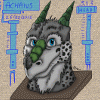
Traditional aeroplane seating is totally unsuited to taur species, so I thought about a better alternative, and came up with this design. For trips of only a few hours, a taur should be able to comfortably squat in these radical new seats. The backrest and armrests ensure the least amount of effort to maintain the position. Under-seat storage is replaced by over-the-void storage and a permanent shelf. A storable folding seat caters for bipeds, while still allowing plenty of space for those with large tails. This compact arrangement takes up about 40% more space than standard biped-only seating, as opposed to double the size for a typical taur couch arrangement, and gives greater comfort to bipeds with tails.
Category All / All
Species Chakat
Size 1176 x 814px
File Size 240.3 kB
The box-like construction is certainly going to make the seat strong enough to withstand a crash, but how is it attached to the taur sitting in it? In a crash, how does this seat prevent the chakat's lower torso from sliding forwards? I can imagine situations where restraining the upper torso alone causes more harm than good. I assume that there are either two life vests under the food tray? (And that there is an expandable food tray below the screen?) Either one for humanoids and one for taurs, or a regular vest and a second add-on for a taur's lower torso. The Biped seat also looks like it might attract a safety inspector's eye.
Would taurs be able to sleep comfortable in this design? Even if it's only used for short haul flights (or if supersonics has turned every flighty short haul) passengers still like to nod off. That screen is also very unergonomic. Have you considdered raising the screen and luggage space, and extending the 'food shelf' underneith them?
Would taurs be able to sleep comfortable in this design? Even if it's only used for short haul flights (or if supersonics has turned every flighty short haul) passengers still like to nod off. That screen is also very unergonomic. Have you considdered raising the screen and luggage space, and extending the 'food shelf' underneith them?
Firstly - this is a concept drawing, not a finished design. I can already see ways of improving this.
Secondly - I am not an engineer, so I cannot give exact answers to some things, although I do know enough to see that there's real potential to find solutions.
So now to address your points:
1. For the crash scenario, obviously the traditional lap belt would be pretty useless. I see instead an X harness with four anchor points high and low. That should do a superior job of restraining the lower torso as well as the upper.
2. Life preserving equipment will be whatever safety regulations specify. (However I think you underestimate the buoyancy of the taur torso. All you need to do is keep the head above water so that they don't drown, so a vest for the upper torso might be enough.)
3. An extendible tray is just one of the many tweaks I envisage.
4. The biped seat would have to be specifically designed by an engineer using suitable materials. I believe it can be done properly. I just don't have the engineering background to be able to be more specific.
5. Taurs can sleep like this with the headrest and armrests supporting them. However, as specified, this is designed for shorter duration flights where the need to sleep is not a specific requirement to cater for. I have a different idea in mind for long-haul flights.
6. The screen is supposed to be able to pivot at the top to get the ideal viewing angle, just like they do in planes right now.
7. No, I don't want to raise the luggage space more because it gets progressively harder to pull your luggage out, the higher it gets. Also, taking it out the side is not always going to be an option if you have one or two more next to each other. Also, at this height, you can readily access the contents of many types of bags without having to remove it from the carrier.
Bottom line - I believe that this concept can be tweaked to meet all the needs of both passengers and airlines.
Secondly - I am not an engineer, so I cannot give exact answers to some things, although I do know enough to see that there's real potential to find solutions.
So now to address your points:
1. For the crash scenario, obviously the traditional lap belt would be pretty useless. I see instead an X harness with four anchor points high and low. That should do a superior job of restraining the lower torso as well as the upper.
2. Life preserving equipment will be whatever safety regulations specify. (However I think you underestimate the buoyancy of the taur torso. All you need to do is keep the head above water so that they don't drown, so a vest for the upper torso might be enough.)
3. An extendible tray is just one of the many tweaks I envisage.
4. The biped seat would have to be specifically designed by an engineer using suitable materials. I believe it can be done properly. I just don't have the engineering background to be able to be more specific.
5. Taurs can sleep like this with the headrest and armrests supporting them. However, as specified, this is designed for shorter duration flights where the need to sleep is not a specific requirement to cater for. I have a different idea in mind for long-haul flights.
6. The screen is supposed to be able to pivot at the top to get the ideal viewing angle, just like they do in planes right now.
7. No, I don't want to raise the luggage space more because it gets progressively harder to pull your luggage out, the higher it gets. Also, taking it out the side is not always going to be an option if you have one or two more next to each other. Also, at this height, you can readily access the contents of many types of bags without having to remove it from the carrier.
Bottom line - I believe that this concept can be tweaked to meet all the needs of both passengers and airlines.
I am quite aware you are not an engineer, but if you happen to recall, I am. So I thought I might point out a few issues you probably hadn't thought of, which you could ponder if you wished to take this design further. As several others seem to have done. In mechanical engineering, unlike art, there are actually wrong answers.
For example, as a real life health and safety issue, all mammals float (including humans) but without correction, they float face down, because limbs are heavy and they tend to fall forwards. Life vests aren't designed to help you float so much as increase the chance you float face up with your head tilted backwards. Given taur boyancy and weight distribution, I don't believe this is going to be as easy as you think.
For example, as a real life health and safety issue, all mammals float (including humans) but without correction, they float face down, because limbs are heavy and they tend to fall forwards. Life vests aren't designed to help you float so much as increase the chance you float face up with your head tilted backwards. Given taur boyancy and weight distribution, I don't believe this is going to be as easy as you think.
Interesting design, although, I'm wondering two things.
1.) Seat arrangement. Will it be traditional coach seating for narrow-body planes (3 and 3, one isle. Think Boeing 737) or would it be 2 and 2 throughout the entire cabin? Or would it be 2 and 3?
2.) Floor and leg space. How would a taur be able to sit? And would a biped be able to sit next to a taur?
1.) Seat arrangement. Will it be traditional coach seating for narrow-body planes (3 and 3, one isle. Think Boeing 737) or would it be 2 and 2 throughout the entire cabin? Or would it be 2 and 3?
2.) Floor and leg space. How would a taur be able to sit? And would a biped be able to sit next to a taur?
Seat arrangement will be whatever suits the particular aircraft. However, as a rule, the seating will be pretty much the same as it is today. Only the distance between them forward to back is increased, not the width.
The taur would probably find it easiest to back into the seat. Yes, a biped can sit next to a taur.
The taur would probably find it easiest to back into the seat. Yes, a biped can sit next to a taur.
other then a few points brought up by anticarrot this is a pretty good concept and not bad for a first attempt. It's always nice to see taur-specific furniture since usually people take the easy way out with floor mats, beanbag chairs, etc. with only the taur-seats with a back support being just about the only real taur-specific piece in most stories, if that.
I can see:
1. Issues with getting in and out of this arrangement. A flexible chakat not so much (although backing in would be annoying), but fox- and wolftaurs might be limited to aisle seats. You also probably wouldn't get out past another passenger.
2. The need of a cushion between the forward legs, probably combined with restraints for the lower body.
3. Bipeds being allowed additional carry-on baggage (to be stowed in the 'taur well).
4. Airlines trying to balance this kind of 'taur seating with passenger "density."
I suspect it's more likely that 'taurs would be accommodated by billing them for two (or more, if appropriate) seats and having them lay cross-wised. The biggest hazard there is turning the upper torso sideways to face forward, although modified restraints might be needed, too.
1. Issues with getting in and out of this arrangement. A flexible chakat not so much (although backing in would be annoying), but fox- and wolftaurs might be limited to aisle seats. You also probably wouldn't get out past another passenger.
2. The need of a cushion between the forward legs, probably combined with restraints for the lower body.
3. Bipeds being allowed additional carry-on baggage (to be stowed in the 'taur well).
4. Airlines trying to balance this kind of 'taur seating with passenger "density."
I suspect it's more likely that 'taurs would be accommodated by billing them for two (or more, if appropriate) seats and having them lay cross-wised. The biggest hazard there is turning the upper torso sideways to face forward, although modified restraints might be needed, too.
1. I think you seriously overestimate the difficulty of backing into one of these seats. As for getting past other passengers - have you tried getting out of a window seat in economy class lately? I sure can't do it without the other passengers getting out first!
2. Cushion? I don't get it.
3. Carry-on is a matter of weight, not just quantity. However, it's quite possible that the well might still get used. After all, I can take a bag and a "personal item" on board a plane. That personal item is usually a laptop bag.
4. As this has been designed specifically for a population that has a large proportion of morphs and taurs, I think that the airlines can figure out that density fairly well.
5. I can't see the crosswise seating happening on short-haul flights. It's far more economical to pack in lots of people, and this design maximises that. However, for long-haul flights, I see a different kind of seating - stalls actually. They'd all be crosswise, but the consoles would be at one end, so no head-turning would be necessary. Also, in a prone position, emergency netting would be more effective in restraining a taur, combined with having a wall between stalls to give a full-length bracing.
2. Cushion? I don't get it.
3. Carry-on is a matter of weight, not just quantity. However, it's quite possible that the well might still get used. After all, I can take a bag and a "personal item" on board a plane. That personal item is usually a laptop bag.
4. As this has been designed specifically for a population that has a large proportion of morphs and taurs, I think that the airlines can figure out that density fairly well.
5. I can't see the crosswise seating happening on short-haul flights. It's far more economical to pack in lots of people, and this design maximises that. However, for long-haul flights, I see a different kind of seating - stalls actually. They'd all be crosswise, but the consoles would be at one end, so no head-turning would be necessary. Also, in a prone position, emergency netting would be more effective in restraining a taur, combined with having a wall between stalls to give a full-length bracing.
1. It's not the backing in that would be the issue, but turning the corner while doing so in the narrow space between rows. This of course assumes two- or three-wide seating with the most difficulty being seats along the bulkhead or otherwise not along an aisle. (Yes, I've had to deal with tight seating on planes. It's marginal but doable with the right builds.)
2. You depict the 'taur as propped up on hir forelegs. Something to rest that lower torso on would be nice (and might double as part of the restraint system if done right). Also consider that laying on the (obviously padded) deck would also mean the upper torso comes forward slightly.
...
4. See #5. I'd think it more likely on Chakona than Earth. (Relative to #1, might it be deployed as part of mixed seating, these placed along the aisles and biped-specific seats for the rest?)
5. While you estimate this design allows (smaller) 'taurs to take the space of only 1.4 bipeds instead of 2, it also applies to every passenger, 'taur and biped. A lot would depend on the exact ratio of 'taurs to bipeds.
For the question of "sideways," I'm thinking less of passenger comfort and more of safety. Much would depend on the effects of acceleration on a 'taur's body. (For bipeds it's face forward for takeoff, face backward for most crashes, both assuming your seat back is behind you.) Any arrangement that makes the subject want to twist sideways adds to the hazard (and may be uncomfortable). The "accommodation" would happen only in vehicles not adapted to seating 'taurs.
2. You depict the 'taur as propped up on hir forelegs. Something to rest that lower torso on would be nice (and might double as part of the restraint system if done right). Also consider that laying on the (obviously padded) deck would also mean the upper torso comes forward slightly.
...
4. See #5. I'd think it more likely on Chakona than Earth. (Relative to #1, might it be deployed as part of mixed seating, these placed along the aisles and biped-specific seats for the rest?)
5. While you estimate this design allows (smaller) 'taurs to take the space of only 1.4 bipeds instead of 2, it also applies to every passenger, 'taur and biped. A lot would depend on the exact ratio of 'taurs to bipeds.
For the question of "sideways," I'm thinking less of passenger comfort and more of safety. Much would depend on the effects of acceleration on a 'taur's body. (For bipeds it's face forward for takeoff, face backward for most crashes, both assuming your seat back is behind you.) Any arrangement that makes the subject want to twist sideways adds to the hazard (and may be uncomfortable). The "accommodation" would happen only in vehicles not adapted to seating 'taurs.
I doubt they'd need to though - since the planes have to be bigger than what we know today (on account of taurs just being larger and heavier than bipeds), the engines would have significantly higher power-to-weight ratio and thus greater propulsion and lifting capacity.
It would probably be very much the same as one of those seats facing a bulkhead on today's planes. I admit that it's not the best, especially if you've got long legs like me. I think a bit of tweaking would give a few more inches, but certainly not be able to stretch under the seat like today's aeroplanes. It is a compromise design though, and one certainly biased towards the taurs, but considering the location, that's hardly surprising.
Nicely done, I like the way the layout is set up, particularly with regard to the colapsable slide biped seats. I would suggest that it might be necessary to space them a tad farther fore-and-aft than is laid out here, primarily for the comfort of a biped. A good deal of the current foot-space (not necessarily leg room, but space for the big clodhopper feet like some of us have) is provided by being able to have them under the seat ahead of you, around your carry-on bag. That would not be possible in this arrangement, in the situation of a biped sitting directly behind a 'taur. Not an insurmountable issue, just something that would have to be compensated for in density of seating.
Second concern would be space for the 'taur's tail. Most 'taurs seem to have particularly luxurious tails, and particularly long ones in the case of Chakats. I see potential for tail cramps developing on longer flights with no room to move or extend them.
I'm not particularly familiar with the anatomical specifics of the torso/taur-back junction in the Chakat or Foxtaur species, but would the issue of restraining the upper body, and having the lower body slide forward and out in a frontal impact put excessive force on that junction? Also, in the event of a wreck, is there provision for extracting an injured 'taur's torso from the "compartment" that holds it? Particularly if the impact was excessive, and structural buckling of the aerospace frame took place. That tends to weak havoc with fastenings and compartment lids.
Second concern would be space for the 'taur's tail. Most 'taurs seem to have particularly luxurious tails, and particularly long ones in the case of Chakats. I see potential for tail cramps developing on longer flights with no room to move or extend them.
I'm not particularly familiar with the anatomical specifics of the torso/taur-back junction in the Chakat or Foxtaur species, but would the issue of restraining the upper body, and having the lower body slide forward and out in a frontal impact put excessive force on that junction? Also, in the event of a wreck, is there provision for extracting an injured 'taur's torso from the "compartment" that holds it? Particularly if the impact was excessive, and structural buckling of the aerospace frame took place. That tends to weak havoc with fastenings and compartment lids.
Not a bad idea, although I'm not sure where it would be stowed. However I wasn't planning on any elephant morphs sitting on one.
Actually the biggest problem with the swing & lock seat probably would not be its load capacity, but the cost of the materials that would be strong enough to meet the design requirements.
Actually the biggest problem with the swing & lock seat probably would not be its load capacity, but the cost of the materials that would be strong enough to meet the design requirements.
Take into account you have a couple hundred years more of materials sciences beyond what is available now to call upon. Assuming the need and technology had been available the price of raw materials alone to build an aluminum 747 fuselage in 1880 would have probably bankrupted any company or country trying to do it. Who can say what might be affordable to Chakona Air?
Nicely done...
But think of this.
1. If the plane hits heavy turbulence, rocketing side to side. What could get knocked free?
2. If the plane crashes, and rolls. What would fly about?
3. If the plane runs off the runway into the sand trap. What would slip/crash forwards?
Also consider this. Accidents don't happen every day. What is a good balance between comfort and safety.
I would say, a cushion that folds from the floor against the chest to lock the lower body into the lower body area. This would also prevent the sliding in the event of a bump or quick stop and it would give a place to rest the lower torso.
However... I've tried to find an animation of the current aviation seats behavior in a crash. My internet is just bad today. The seats are made on flexible legs. During a crash it looks like a water ripple running along the body of the plane. This caused old seats to tear loose and the people in their seats went flying. No plane has these old seats anymore due to aviation regulations.
The current hip safety belts could still do the job nicely, and allow free upper body movement. Although an extra point or two would be nice if you going to try and get in a nap apart from the extra safety aspect.
The place for carry on baggage I like, but make it so it is secure. In the picture it looks like its only an open place to put it where it could fly out. IT would give more head room in the seating spaces although the window seat would still be cramped.
But think of this.
1. If the plane hits heavy turbulence, rocketing side to side. What could get knocked free?
2. If the plane crashes, and rolls. What would fly about?
3. If the plane runs off the runway into the sand trap. What would slip/crash forwards?
Also consider this. Accidents don't happen every day. What is a good balance between comfort and safety.
I would say, a cushion that folds from the floor against the chest to lock the lower body into the lower body area. This would also prevent the sliding in the event of a bump or quick stop and it would give a place to rest the lower torso.
However... I've tried to find an animation of the current aviation seats behavior in a crash. My internet is just bad today. The seats are made on flexible legs. During a crash it looks like a water ripple running along the body of the plane. This caused old seats to tear loose and the people in their seats went flying. No plane has these old seats anymore due to aviation regulations.
The current hip safety belts could still do the job nicely, and allow free upper body movement. Although an extra point or two would be nice if you going to try and get in a nap apart from the extra safety aspect.
The place for carry on baggage I like, but make it so it is secure. In the picture it looks like its only an open place to put it where it could fly out. IT would give more head room in the seating spaces although the window seat would still be cramped.
Hmm....
I'm thinking maybe have the biped seat fold DOWN, and have the underside provide lumbar support for taur passengers.
But I agree that I don't see a particularly effective crash harness in the "facing forward" configuration. The problem with a "lap belt" is that it would have to bear the complete mass of the passenger, likely applied to the joints of the lower elbows. While blowing out or severing the joints is better than dying, it would be crippling to a taur and would prevent the passenger from evacuating the crashed vehicle. A sideways configuration is probably more survivable, as the force would be spread across the entire body.
Now, a TRULY bizarre idea: Modular seating rows that slot in from the sides. Not have any first-class passengers? Swap out two first-class rows for three coach-class. Got a taur on board? Slot in a taur couch. Got a Rakshani along for the ride? Put in a module with a half-overhead compartment.
Really, I think commuter aerospace craft in the CU would have to be completely rethought from the ground up, given the wide variety of shapes and sizes that a particularly cosmopolitan world like Chakona would have to deal with.
I just had some wacky thoughts... I might draw something later...
I'm thinking maybe have the biped seat fold DOWN, and have the underside provide lumbar support for taur passengers.
But I agree that I don't see a particularly effective crash harness in the "facing forward" configuration. The problem with a "lap belt" is that it would have to bear the complete mass of the passenger, likely applied to the joints of the lower elbows. While blowing out or severing the joints is better than dying, it would be crippling to a taur and would prevent the passenger from evacuating the crashed vehicle. A sideways configuration is probably more survivable, as the force would be spread across the entire body.
Now, a TRULY bizarre idea: Modular seating rows that slot in from the sides. Not have any first-class passengers? Swap out two first-class rows for three coach-class. Got a taur on board? Slot in a taur couch. Got a Rakshani along for the ride? Put in a module with a half-overhead compartment.
Really, I think commuter aerospace craft in the CU would have to be completely rethought from the ground up, given the wide variety of shapes and sizes that a particularly cosmopolitan world like Chakona would have to deal with.
I just had some wacky thoughts... I might draw something later...
as has been said, stronger stuff (or a couple more latch points) fixes the non taur seat.
I too think 'sitting up' would be tiring, either a prop up pad or enough room to lay the lower torso down. (see how long a cat or dog will 'sit' before getting more comfortable )
as for safety, stasis fields are your friend (and if the craft is so badly damaged that the fields fail - well, you didn't have much of a chance anyway ...)
nice idea
I too think 'sitting up' would be tiring, either a prop up pad or enough room to lay the lower torso down. (see how long a cat or dog will 'sit' before getting more comfortable )
as for safety, stasis fields are your friend (and if the craft is so badly damaged that the fields fail - well, you didn't have much of a chance anyway ...)
nice idea
I agree that 'sitting up' would be less comfortable than a couch, but as I keep pointing out, this is designed for short-haul commuter flights. I don't know about you, but I've stood up in crowded trains for longer than an hour, and standing is a lot harder than the squat position indicated. Still, there may be a way to design a lower torso support.
And as for crashes, a stasis field is certainly the perfect answer... if it can be small enough to be practical to install.
And as for crashes, a stasis field is certainly the perfect answer... if it can be small enough to be practical to install.
Awesome idea! Something I'd never have thought of o.o May I possibly use a derivative of this in my spaceship/arcology/colony project? It'll have genetically modified humans, some of which will probably have modified into taurs of some variety (which I hadn't actually thought of until now, but it would probably have come up at some point) and this is really freakin' clever :D
Ok a couple things to me.
Even on short flights i'd want to lay down. It's more comfy. there should be more space. you are in a tight area so how are you going to get comfy in that tiny space which brings up another point
How do you get in? The space is too low and too small to squeeze your big taur butt into. or if you has a big fluffy tail like mine you won't fit as well. You can't back in unless you were slender taur but even if you were slender taur you'd be too tall to get under the cave. it also would get hot in there. big thick fur in a tiny space with heat coming out wouldn't quite work. plus the front area is too small to walk through. i bipedals already have trouble and taurs are bigger.
Even on short flights i'd want to lay down. It's more comfy. there should be more space. you are in a tight area so how are you going to get comfy in that tiny space which brings up another point
How do you get in? The space is too low and too small to squeeze your big taur butt into. or if you has a big fluffy tail like mine you won't fit as well. You can't back in unless you were slender taur but even if you were slender taur you'd be too tall to get under the cave. it also would get hot in there. big thick fur in a tiny space with heat coming out wouldn't quite work. plus the front area is too small to walk through. i bipedals already have trouble and taurs are bigger.

 FA+
FA+

















































Comments